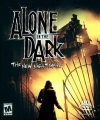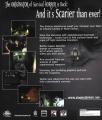Alone in the Dark: The New Nightmare
First posted on 29 August 2006. Last updated on 29 September 2009.
In 1993, developer I-Motion and publisher Infogrames partner together to produce a game that is undoubtedly among the most influential titles in the early era of 3D gaming. It heralds the establishment of survival horror as a gaming subgenre which has since been popularized by other action adventure series such as Resident Evil and Silent Hill. The original Alone in the Dark, inspired by the work of H P Lovecraft, has won critical acclaims for its groundbreaking graphics, immersing atmosphere, and intense gameplay. Unfortunately, subsequent sequels have not lived up to the great expectation raised thereafter. Now, 8 years later, the fourth game in the series, aptly subtitled "The New Nightmare", attempts to regain the lost reputation for the franchise. Developed by newcomer DarkWorks initially for the console and ported later to the PC by Spiral House, Alone in the Dark: The New Nightmare takes a departure from the 1920s to present day in an attempt to totally revamp its ambience. Is this game a worthy sequel to the once venerable series? Let us shine a light on it...
After discovering that his friend Charles Fiske has been found dead off the coast of Shadow Island, private eye Edward Carnby (the protagonist from the original Alone in the Dark) vows to avenge his death and solve the mystery surrounding this island. Edward is not "alone in the dark" in his mission. This is because an anthropologist named Aline Cedrac, on board the seaplane to Shadow Island with Edward, is also on a mission with intentions of her own. However, when a mysterious shadowy beast attacks the plane, both Edward and Aline are forced to parachute out of the falling aircraft onto the island to safety. Edwards lands in the dark woods surrounding a nearby mansion, while Aline lands on the roof of the mansion itself. As Edward and Aline explore the supernatural charged Shadow Island, each discovers an island filled with terrorizing monsters, a sinister family legacy, Native American black magic, and other occults enough to make their escape a true nightmare.
Like previous titles in the series, this sequel uses pre-rendered environments with strategically and artistically placed camera angles to deliver a true cinematic feel from a third person perspective. The opening and ending movies are the only Full Motion Video sequences used in the game, leaving all remaining cut scenes to be generated entirely as in game sequences. The developer has obviously abandoned the outdated engine used by I-Motion in favor of a brand-new 3D engine capable of rendering gorgeous visuals, even though the resolution is fixed at mere 640x480 pixels. The backdrops are beautifully crafted and appear near photorealistic in quality. Most of the environments in Shadow Island are under eternal darkness, so Edward and Aline are each equipped with a flashlight at the start. The flashlight effect is impressive and a sight to behold. Moreover, the flashlight is not only used for eye candy but can be used to scare away the light sensitive creatures that inhabit the island. This is a nice enhancement, since previous games in the series do not need to contend to exploring under such darkness due to the limited graphic engines used at that time to render the environments. It is also a befitting addition since the name of the series is "Alone in the Dark" after all!
All the creatures in this game are modeled with good details. There are no laughable zombie clowns or cowboys as in previous titles. The monsters are genuinely scary. The character models are well done, except for the fact that their faces are not animated with expressions while they speak. This is a shame since the game looks otherwise very polished, especially with the real-time generated shadows which greatly enhance the realism of its visuals.
Sounds are put to good use to establish the foreboding atmosphere in this game. In fact, the sound effects are guaranteed to make you jump out of your seat and dread on what is lurking around the corner. Banging of the gunfire, growling of the creatures, and howling of the wind come into play perfectly, giving the game an authentic feel of a horror film. The voice acting is first rated and not done in the cheesy “Jill sandwich†style of Resident Evil. The exchanges between Carnby and Aline through their radio communication create interesting conversations and opportunities for character development while providing important clues to the player. This level of interaction is seldom seen in adventure games of this subgenre and is definitely a welcomed improvement. The music used in this game is strange but in a good way. The soundtrack is composed by Thierry Th Desseaux of Low Distortion Unit. While the music may not be the scariest ever created for this series, it still serves well in setting the mood of a dark and gloomy atmosphere that is ubiquitous on the island.
At the start of the game, you choose to play as Edward or Aline. You use the keyboard to control the movement of your character. You use the mouse to aim your flashlight or weapon manually. The default control scheme can be confusing for novice gamers. The learning curve is rather short, so with practice it can easily become manageable. The keys can also be remapped. The game plays differently depending on which character you choose. As Edward, the game is more action oriented with fewer challenging puzzles to solve. He starts out with a customized revolver and gets more ammunition for the weapons he acquires than Aline. He can blast this way through the light sensitive creatures but needs to collect more keys to get around. In contrast, as Aline, the game is more puzzle oriented requiring more thought than reflex. She does not start out with a weapon and has to defend herself against the light sensitive creatures with the flashlight until she acquires herself a revolver or a triple barrel shotgun.
To aid with combat, the game has an auto aim feature that can be activated by pressing the aim key, after which the game can automatically track the creatures coming into your sight. You can even move around while auto aiming. This is particularly useful when you need to back away from an enemy while firing at the same time. You can also aim manually using the mouse, but this leaves you stationary. Weapon reloading is automatic, provided that you have enough ammunition for it. Because it takes time for your character to reload the weapon, it can be troublesome when you are forced to reload while being chasing by a shadow creature. There is no reload key. Manual reloading is done by accessing the inventory screen to combine the available ammunition with the appropriate weapon.
Thankfully, the puzzles in this game are more sophisticated that those typically found in other survival horror games. Some puzzles are a little too obscure and others are a bit tricky to require some clever thinking. As much fun as the romp can be playing as Edward, I personally find playing as Aline to be more satisfying because of these puzzle elements. You can save the game at any time by using the "Charm of Saving" which you can find in limited numbers scattered throughout Shadow Island. The only catch is that once you save a game after entering a new area, everything you have done in that area must be repeated again when the game is reloaded. This can be an annoyance, but it can also be a blessing if you want to quickly reset a puzzle after messing it up. Reflecting its console origin, there are only 4 save game slots.
An interesting gimmick is the inclusion of an "Alone in the Dark" branded flashlight in the box package in a limited release of the game. Despite its origin as a sequel, Infogrames has never officially referred to this game as "Alone in the Dark 4". Regardless, Alone in the Dark: The New Nightmare stands well on its own as an enjoyable title in an overcrowded subgenre. Terror is abundant and well implemented in this action adventure. There are many moments when I nearly jump out of my chair as an enemy appears out of nowhere. This is a game that is guaranteed to make your heart skip a beat. As such, I recommend it to all fans of survival horror as well as fans who are already familiar with the series, with or without the flashlight!






